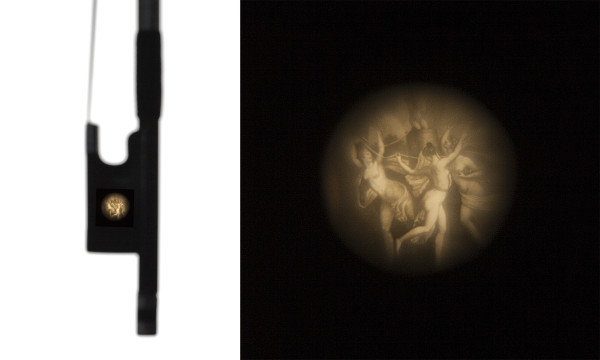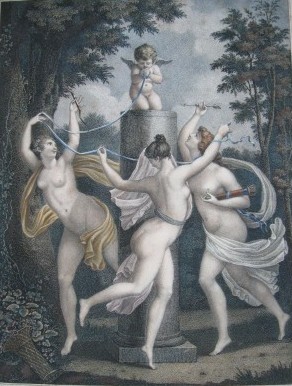I was lucky to have a spate of four or five Pajeots in my workshop around 1990, when I was about to start making again. I had apprenticed with Garner Wilson, who was of the ex-Hill school of bow making, and he had taught me that there was only one way to make a bow. Then in 1987 I found work repairing bows in Paris. Within a few years I was seeing Pajeots, Peccattes and even Tourtes on my bench and I started drawing and studying them – my whole vision of how a bow could look changed dramatically.
I became so influenced by the elegance of the French style that I decided to redesign my bows from the manner that I had been taught. I wanted to find my own design rather than making copies, and for me three makers, Pajeot, Simon and Grand Adam, really stood out, so I tried to absorb their influence and then create my own form. The shape that I liked turned out to be a cross between the three, although of course I’ve refined it over the years.
A fine French violin bow by Etienne Pajeot
I was probably first influenced by Pajeot, post my apprenticeship, and in this bow specifically, I can still see where my own design has come from. It’s the epitome of his workmanship, from the period when he’d really refined his style, making it instantly recognisable as a Pajeot bow. The ring and eye (with the white pearl adjacent to the abalone) is very typical, but the form of the frog is also extremely particular to Pajeot, as is the elegant head.


When I first saw bows like this I was attracted to their aesthetic: the harmony of the proportions. For example, the height of the frog in relation to its length and the shape of the throat are quite simple yet, to me, perfect.

The head of this particular Pajeot is probably the closest to what I do, of any historic bow I know. Pajeot employed a variety of different styles, but there’s always something very elegant about the heads. This bow was probably made around 1840. Around that time Peccatte was starting out, while Persoit and Eury were well established; these makers all had a more rugged style in their bows. To me, Pajeot produced the most elegant bows of these great makers and in my opinion he’s underrated, possibly because he stayed in Mirecourt throughout his life, rather than moving to Paris.
The key thing that I took from my apprenticeship was the incredibly precise workmanship of the Hills’ makers – and that’s partly why I admire Pajeot. A Pajeot bow is both artistic and accurately made, with a quality of work that you don’t see in many Peccattes, for example. Peccatte was all about artistry and flair, but his bows were usually relatively quickly made. Pajeot produced a tidier bow; some might say they are less interesting for that reason but I disagree. There is a lot of variety in his style, yet his bows all have a balanced design overall. I even find the proportions of the button satisfying – the way that the moulding fits to the stick while the diameter of the button is slightly larger than the handle, without being over-heavy.

The workmanship is second to none. The underslide, for example, is very well done – it’s very flat, with well defined, sharp corners. The pearl slide is satisfyingly wide and all the metal fittings are crisp, fitting together perfectly. The ferrule is a lovely semi-circular shape, the curved part being of a typically thin silver; Pajeot would have hammered this part to make the silver harden. When you remove a ferrule from the frog, you find that the silver is springy and retains its shape.

Pajeot always chose fine materials and the stick of this bow is first-class pernambuco: dark, but with golden veins running through it and some lovely light flame.
A fine French picture violin bow by Pierre Simon
This is a classic later Simon bow, made around 1865. When I first saw Simon bows in Paris, it was the elegance of the head and the form of the frog that stood out.


What I like about this example is the beautiful finish of the workmanship and the overall balance of the design. There’s something particularly lovely about the proportions of the head, the way that the chamfers open up and the graceful curve down the front. The frog is of the Vuillaume model, with rounded edges, a rounded under-slide and a rounded ferrule. Overall it is a slightly more bulky bow than the Pajeot, with a fuller and quite tall head.

The bow is not branded Vuillaume and would have been made for a private client as a special order. It has a spectacular lens in the eye, showing a beautiful picture with the inscription: ‘L’Amour enchainé par les graces’ (Love entwined by the Graces). It is the only example known to me of this type of illustration used in a picture bow but I don’t know the original source of the work. I’d love to find it.

Whenever I first see a bow I always look down the stick to see how well planed it is and this one is extremely well finished. Both of these bows are typically oval in form, making the stick higher than wide, rather than triangular like a Peccatte. The Simon has a blond wood with a beautiful flame and is of a similar density to the Pajeot. Both weigh about 60 grams (with tinsel lappings), which is unusually heavy for 19th-century French bows.
These bows have been remarkably well preserved and show little wear. When you find bows in near-mint condition like these, you can really see how these makers worked. A detail worth noting is that the soldering of the ferrule and the button rings is excellent; everything fits together exactly – you can see they were serious craftsmen.
Peter Oxley is a bow maker based in Oxford, UK.
Since we first posted this article, a photogravure of the Simon bow image has been found and is shown below. If any readers know the original artist, we would love to hear from you.

L’Amour enchaîné par les Grâces, gravure Directoire réalisée par Jean Thouvenin